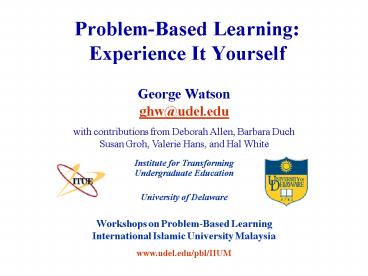ProblemBased Learning: Experience It Yourself - PowerPoint PPT Presentation
1 / 20
Title:
ProblemBased Learning: Experience It Yourself
Description:
What does Pat need to know to assure Kim about his travel plans? What should we ask Kim about Pat to determine if her concerns are legitimate? ... – PowerPoint PPT presentation
Number of Views:77
Avg rating:3.0/5.0
Title: ProblemBased Learning: Experience It Yourself
1
Problem-Based LearningExperience It Yourself
George Watsonghw_at_udel.edu with contributions
from Deborah Allen, Barbara DuchSusan Groh,
Valerie Hans, and Hal White
Institute for TransformingUndergraduate Education
University of Delaware
Workshops on Problem-Based LearningInternational
Islamic University Malaysia www.udel.edu/pbl/IIUM
2
Delaware
Dela where?
3
(No Transcript)
4
the individuals learning the most in the
teacher-centered classrooms are the teachers
there. They have reserved for themselves the
very conditions that promote learning
What I know best I have taught
actively seeking new information, integrating it
with what is known, organizing it in a meaningful
way, and explaining it to others.
Page 35, Huba and Freed, Learner-Centered
Assessment on College Campuses Shifting the
Focus from Teaching to Learning, 2000
5
Characteristics Neededin College Graduates
- High level of communication skills
- Ability to define problems, gather and evaluate
information, develop solutions - Team skills -- ability to work with others
- Ability to use all of the above to address
problems in a complex real-world setting
Quality Assurance in Undergraduate Education
(1994) Wingspread Conference,ECS, Boulder, CO.
6
Recommendations from theCarnegie Foundation
- Make research-based learning the standard.
- Build inquiry-based learning throughout the four
years. - Link communication skills and course work.
- Use information technology effectively.
- Cultivate a sense of community.
Boyer Commission Report
7
John Dewey
- True learning is based on discovery guided by
mentoring rather than the transmission of
knowledge.
8
PBLExperience It Yourself
9
Stage 1 Where?
10
Questions for Stage 1
- What is the problem?
- What things might be troubling Kim?
- What should Pat do next?
11
Stage 2 WHO?
Pat Nostaw is heading to Singapore for an
international education conference. Following
several days at the conference, he is traveling
to Kuala Lumpur to visit a university there.
After that he is heading home to New York City.
- What things might be troubling Kim? Refine the
list of things identified in Stage 1. - What does Pat need to know to assure Kim about
his travel plans? - What should we ask Kim about Pat to determine if
her concerns are legitimate?
12
Stage 3 When?
Pats collaborator Tan is planning a trip to New
York City from Singapore in December to complete
the final project report.
- How does the list of troubling things change
for this different destination? - What are the top three worries you would have
about this trip?
13
What is Problem-Based Learning?
PBL is an learning approach that challenges
students to learn to learn, working
cooperatively in groups to seek solutions to
real world problems.
- PBL prepares students
- to think critically and analytically, and
- to find and use appropriate learning resources.
14
- The principal idea behind PBL is that the
starting point for learning should be a problem,
a query, or a puzzle that the learner wishes to
solve. - Boud (1985)
15
What are the CommonFeatures of PBL?
- Learning is initiated by a problem.
- Problems are based on complex, real-world
situations. - All information needed to solve problem is not
initially given. - Students identify, find, and use appropriate
resources. - Students work in permanent groups.
16
PBL The Process
- Students are presented with a problem. They
organize ideas and previous knowledge. - Students pose questions, defining what they know
and do not know. - Assign responsibility for questions, discuss
resources. - Reconvene, explore newly learned information,
refine questions.
17
The Problem-Based Learning Cycle
Assessment (when desired)
Overview
Problem, Project, or Assignment
Mini-lecture (as needed)
Group Discussion
Whole Class Discussion
Research
Preparation of Group Product
Group Discussion
18
The principal idea behind PBL is?
- PBL challenges students to learn to learn.
- Learning is initiated by a problem.
- Student-centered work in permanent groups.
19
- The principal idea behind PBL is that the
starting point for learning should be a problem,
a query, or a puzzle that the learner wishes to
solve. - Boud (1985)
20
The principal idea behind PBL is?
- A. PBL challenges students to learn to learn.
- B. Learning is initiated by a problem.
- C. Student-centered work in permanent groups.
Think/ pair/ share































